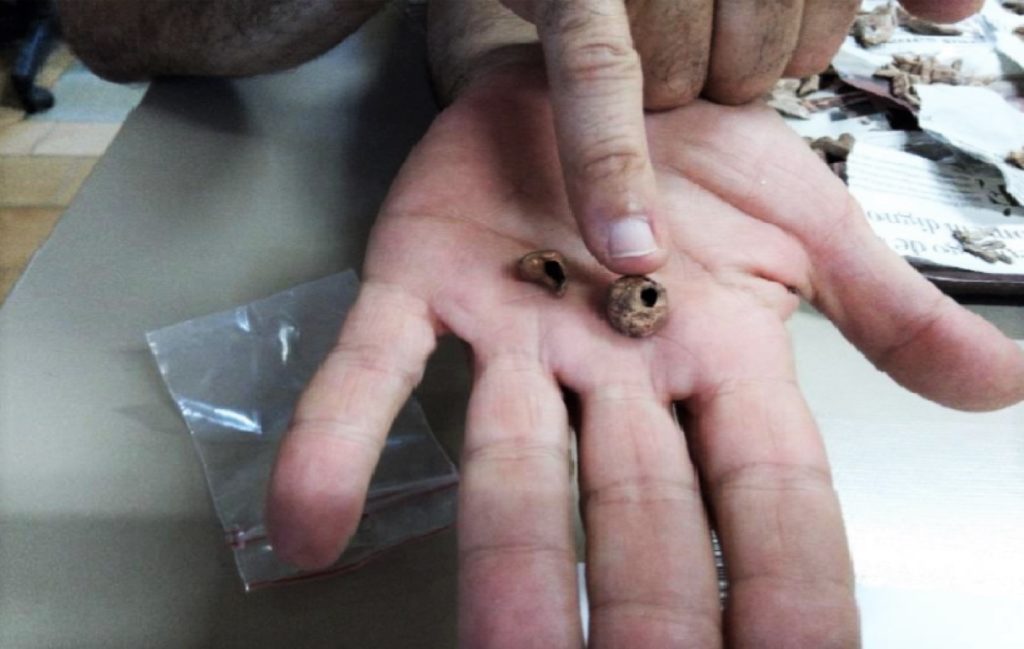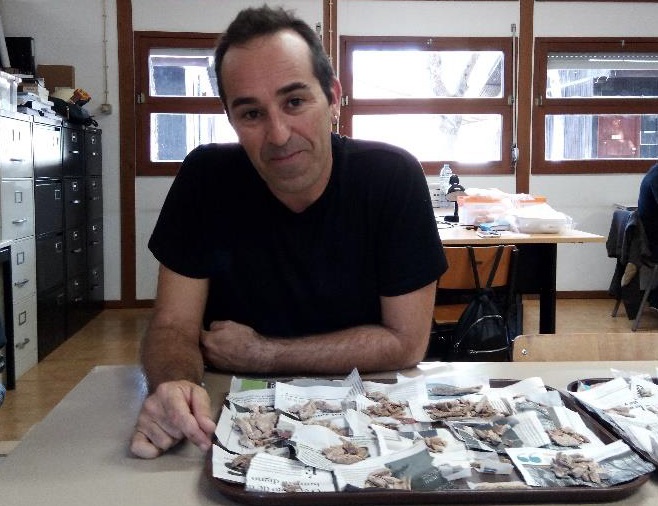 There are no statues, no coins, no pottery, no walls. The first men were casual, frugal and their activities left little trace. Lino André is looking for glimpses into the lives of the first men who inhabited the Algarve 32 thousand years ago.
There are no statues, no coins, no pottery, no walls. The first men were casual, frugal and their activities left little trace. Lino André is looking for glimpses into the lives of the first men who inhabited the Algarve 32 thousand years ago.
Lino André is an archaeologist and does scientific research at the Interdisciplinary Center for Archeology and Evolution of Human Behavior (ICArEHB) at the University of Algarve. He spends most of his days at the J24 laboratory, in a pre-fabricated wooden structure surrounded by stone pines. reminds the bungalows from a campsite, you can hear birds and the sound of branches swaying in the wind. Smells of weeds.
Every time they arrive from the excavation, the investigators bring boxes and boxes of small brown clods, which were retained in the sieves, but they don't know if they are parts of the soil or something else. Only when the washing is done do the findings begin to appear. «It takes hours a day to wash small fragments. For every day of excavation, there are three days to wash and label in the laboratory», says Lino André.
The task that pleases the investigator most is to sit down in front of a table full of hundreds of small clean fragments and sort them by raw material. «This is bone, this is shell, this is lithic [stone]», shows Lino André, holding small fragments in turn, as he places them on pieces of torn newspaper. What appears to be a tedious process is, for Lino, a continual discovery. "When working on excavations in the Upper Paleolithic, this is the kind of evidence we have."
When he gathers the bags full of small bone fragments, Lino André realizes that the inhabitants of the area at that time ate more rabbit than in the level they dug out last year. «At other times, more cockles appear. They also hunted a huge ox that existed at the time, the aurochs», he explains. “We have found bones of many species, especially horse and deer, but also bear, wolf, lynx and, curiously, a phalanx of lion”. Pause, raise your eyebrows and purse your lips. "We still don't quite know what it means."
The excavation from which the hundreds of fragments in the trays in front of Lino André come from is located in Vale Boi, near Vila do Bispo, in the Algarve. Occupation of this place was regular between 33 and 7 years ago.

On the board, there are many small piles of shell fragments, which show the importance of seafood and fish in the diet of these groups. By the way, it is thought that the proximity to the coast was also a criterion for choosing this location by bands of hunter-gatherers.
What also contributed to the choice of this place was the proximity to a water line, where animals gathered to drink, which facilitated hunting. «At a higher point, at the top of the slope, the place that worked as a shelter was found. It would be a recess in limestone where they would shelter and would have a privileged view over the river valley».
Finding these deposits was not easy, as there are no built structures. Until the mid-90s, there was almost no data on human occupation in the Paleolithic region of southern Portugal. The discovery of prehistoric archaeological sites in the Algarve was the result of a prospecting campaign carried out by Nuno Bicho, archaeologist and director of the ICArEHB. During this campaign, he looked for possible shelter locations, close to water courses and the coast, where there were also sources of flint for the manufacture of utensils.
Lino André explains his fascination with the task of separating fragments. «Only I have this overall vision, because I'm the one who sorts the fragments by raw materials. I see for the first time what is there and what is most abundant. It's as if the first discovery was only truly made now. Then each person will analyze only a fraction». Individualized materials are packaged, labeled and inventoried. It is once again a job that requires great concentration and patience.
 symbolic objects
symbolic objects
Is this piece a ground stone or is it a fragment of a utensil? Is this shell broken or has a hole made by humans? This distinction can only be made by someone with specific training and a lot of experience.
The pieces of interest are separated, photographed in a separate location, described and rigorously measured. One by one. It is necessary to identify the animal species to which the pieces used to produce the artefacts belong, using bibliography and copies of reference collections.
“In some cases, we asked for help from colleagues in the Department of Biological Sciences, who have always been very helpful. There are specimens that are sub-fossils and have already lost their chromatic characteristics, making their identification more difficult. The most common shells are the litorinas (burriés)».
From time to time, a very subtle smile, the eyes sparkle, it's a pierced shell. "They're just shells, like the ones we find on the beach today, but there's something very rare about them." Lino separates these pierced shells and takes them to another desk, where there is a magnifying glass connected to the computer. Now you need to check whether the hole is natural or man-made, has wear marks. He wants to know what technology was used to carry out the drilling. What could bear these adornments has already disappeared. Could be made of horsehair, vegetable fibers, leather straps. It is not known.
The pieces that are assumed to have been used for body adornment are one of the aspects of mobile art. This is part of the investigation into the origins of the symbolism and genesis of art that characterize the anatomically modern man. «Since the remote moment when, through thought, the capacity for abstraction was acquired, the path was opened for the symbolic», can be read in the thesis of Frederico Tatá Regala, winner of the Archeology and Human Evolution award in 2016, in a study about the adornments discovered in Vale Boi.
"In these days, the bracelet that simply embellishes the wrist has a very different symbolism from the wedding band or military mottos and, despite that fact, all these elements could fall into the category of adornments."
The comparison between the ornaments found in Vale Boi and other archeological deposits from the same period points to the arrival of this group of humans from the Iberian Mediterranean, replacing the previous Neanderthal population (regardless of the possibility of mixing between the two populations), concludes a study of the ICArEHB published this year in the journal Quaternary International. These are the first anatomically modern men, our Adams and Eves, and wore shell necklaces.
While in the laboratory, Lino André doesn't think about all these implications. It is focused on each piece, with its music on headphones and abstracted from everyday problems. “It's therapeutic”. From his desk, Lino looks ahead. What you see are boxes and boxes of plastic bags on high shelves. “They are like a database. Everything is very organized. There are no arms and eyes for so much. It's for when it's done. If not me, it will be someone else».
Author: Ana Matias, Coastal Geologist and researcher at the Marine and Environmental Research Center of the University of Algarve


















Comments